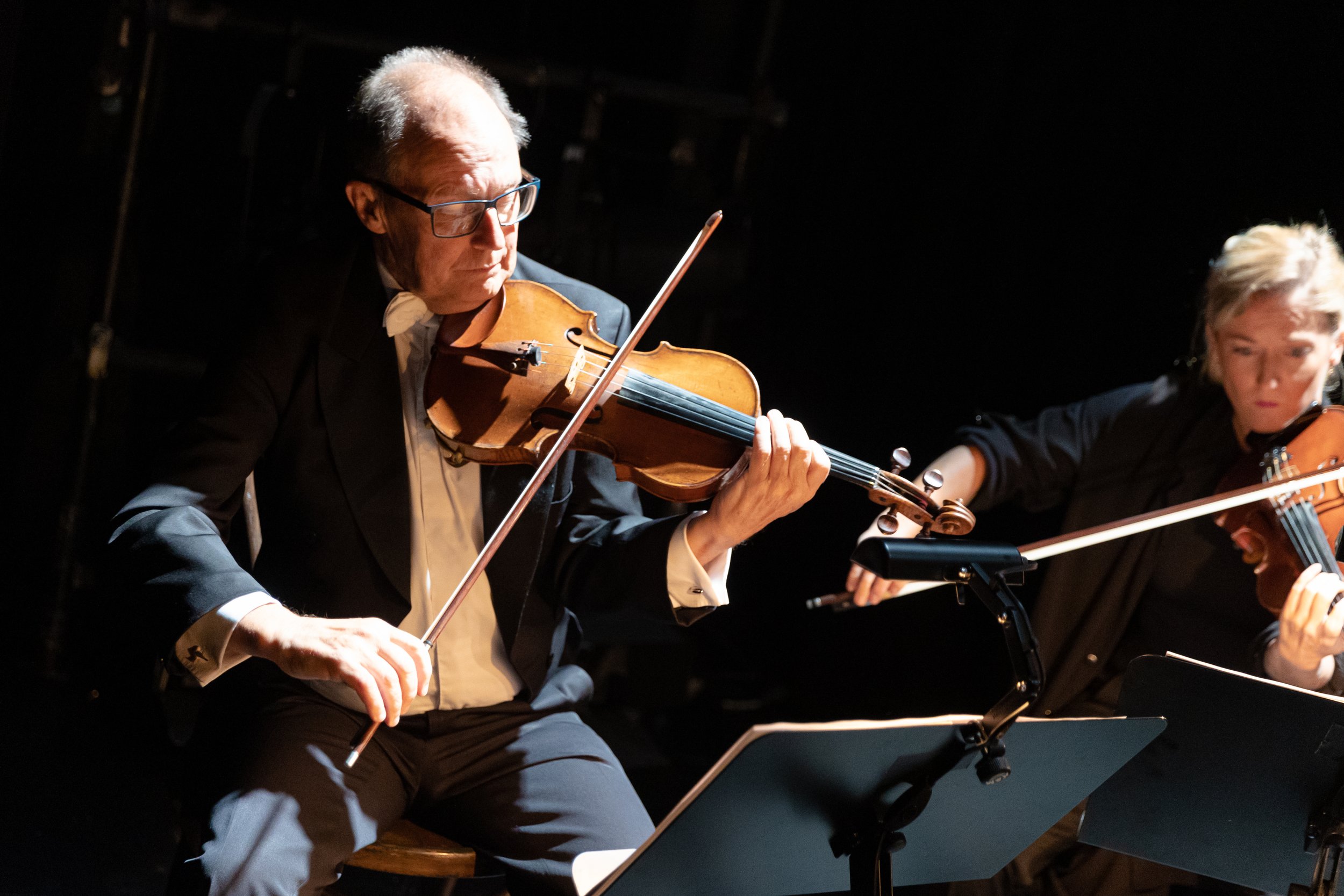In Bed With Schoenberg: notes from a musical scandal
Actor Gavin Rutherford as composer Arnold Schoenberg
Photo credit: ROC Photography
Writing a contemporary play about revolutionary Viennese composer Arnold Schoenberg and illustrating it with music by Schoenberg and his pupils Alban Berg and Anton Webern seems almost as audacious as Schoenberg’s own musical path in the early years of the 20th century. The composer’s music caused riots in Vienna when it was composed and was box office death for performers for many years.
Yet Dave Armstrong’s play, In Bed with Schoenberg, with live string quartet led by Armstrong’s brother Donald, associate concertmaster of the NZSO, is attracting excellent houses and delighting audiences at Wellington’s Circa Theatre. Could the world be ready for Schoenberg’s atonal compositions at last?
In February 1913 the conventional Viennese audience took their seats with suspicion to hear his early work Gurrelieder, composed in 1900, a massive composition for orchestra, multiple choirs and solo singers. They were won over, cheering Schoenberg in an hour-long ovation. But in the decade between writing Gurrelieder and that successful performance, Schoenberg’s musical language had shifted radically, and he and his disciples abandoned tonality completely. Schoenberg believed himself a victim of historical inevitability. When asked in the army if he was "this notorious Schoenberg" he replied: "Yes, sir. Nobody wanted to be, someone had to be, so I let it be me".
In March 1913, Schoenberg organized a concert which included his own Chamber Symphony No 1 Opus 9 and Berg’s Altenberg Songs. This time the outraged audience, punching each other, booing and whistling on their house keys (the traditional Viennese disapproval mode), created such an uproar the police were called, and the rest of the programme abandoned. “The scandal has never ceased,” the composer said many years later.
Writer Dave Armstrong
…a brilliant sketch of the story of a tormented artist
Armstrong’s play opens in Los Angeles, California, with Schoenberg on his deathbed. The composer moved to America in 1933 when the Nazi regime came to power in Germany, first to Boston and then to LA, where he lived till his death, aged 76. In a cleverly constructed script, a single actor playing Schoenberg carries the whole dramatic narrative, unfolding the fascinating life story of one of music history’s most significant modern composers, inventor of the 12-tone serial method. Using some of Schoenberg’s most famous words – “my music is not modern, only badly played” – Armstrong brilliantly sketches the story of an artist tormented by his place in music history and later because of his Jewish religion.
Actor Gavin Rutherford is Schoenberg, splendidly capturing a mostly unlikeable, unsmiling man, egotistical, entitled and aggrieved that his music is not understood or appreciated. “Art is not for the masses,” says Schoenberg, an unashamed elitist. His love for his first wife Mathilde, however, and his outrage at her adultery and painful grief when she dies draw the audience into a more sympathetic relationship with a flawed but genuinely suffering character. Armstrong’s satirical sense also allows Schoenberg occasional dry humour and pokes a little mocking fun at this self-important man as he reminisces about his life and composing career.
Violinist Donald Armstrong leading the live on-stage string quartet
…music is essential to the play’s narrative arc
Photo credit: ROC Photography
An essential part of the play’s narrative arc is the string quartet on stage, led by violinist Donald Armstrong. It illustrates and beautifully connects the story with two dozen carefully chosen and finely played short excerpts. Alongside Schoenberg’s own compositions and those of Berg and Webern is music by Schubert, Puccini, Stravinsky, Gershwin, and others. Schoenberg’s contention that he was far from the first to write dissonant music is tellingly illustrated by the quartet’s offering of brief snippets from Bach’s Musical Offering, Mozart’s “Dissonance” String Quartet and Beethoven’s tonally mysterious Grosse Fuge.
The ending of the play exemplifies the thoughtfulness of the musical choices. Schoenberg suffered from a superstitious fear of the number 13 and was convinced he would die on Friday, 13 July 1951, aged 76 (since 7+6 = 13). In the play, as midnight approaches, he lies down on his bed, expecting his heart to stop beating. The accompanying music is a quartet arrangement of Mahler’s beautiful Adagietto from his Symphony No 5, written as a love letter. Mahler, we’ve heard, was one of Schoenberg’s most loyal supporters during his difficult years in Vienna. The Adagietto is familiar from its use in Visconti’s iconic movie Death in Venice, based on Thomas Mann’s novella. Mann was also in Los Angeles as a refugee from Germany, as Schoenberg told us earlier in the script. Thus, a subtle web of connections underpins this lovely musical conclusion to a complex and multi-faceted story.
In Bed with Schoenberg by Dave Armstrong (writer), with Conrad Newport (director) Gavin Rutherford (actor) Donald Armstrong (music director) William Smith (set and lighting design) Circa Theatre, Wellington until 17 March 2023. (Tickets here.)



